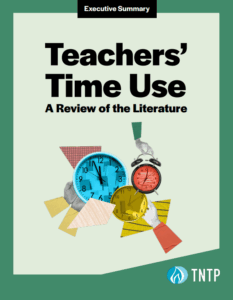Master teachers. Lead teachers. Teacher leaders. You hear these phrases a lot these days, offered up as a long-overdue solution to the flat trajectory teachers follow throughout their careers, where day one looks a lot like the day before retirement.
But teacher leadership is not a new concept—and these “new” roles often look a lot like the old ones. For generations, we’ve asked teachers to take on “leadership roles” that are basically supersized teaching jobs: regular teaching duties, with a side of additional tasks for additional pay. So they teach, and write curriculum over the summer. Or they teach, and mentor student teachers or handle textbook purchases on their off-hours.
These roles are rarely selective. They almost never build on each other or lead to any meaningful promotion for high performers. The worst of these are like summer waitressing jobs, at school—“one-off” opportunities to earn a little extra cash. While I have yet to meet someone who doesn’t want to figure out how to keep our best teachers teaching, in most places, the only upward mobility that combines meaningful status, pay, and responsibility is to leave the classroom behind and move into administration.
Our failure in education to create a modern career progression for teachers where they have opportunities to apply their talents in different and more challenging ways while continuing to work directly with students is out of step with where we are as a society. Few people entering the workforce expect to do the same job for 10 years, let alone 40. We’ve failed to recognize that our popular idea of how teachers progress through a career is as outdated as our common assumptions about how children learn.
Rather than engaging once again in a limited role design exercise where we create differentiation in name only, let’s have a real dialogue around teacher career progression and choices for professionals. Let’s start from the ground up, and imagine a selective profession (like law, medicine, engineering or finance) where the bar to advance is rigorous, but the opportunities to pursue mastery and remain challenged are ample.
In this new teaching profession, high performers are given the opportunity to increase not only their responsibility but also their influence, and progression through one’s career yields greater responsibility, flexibility and autonomy. Their talents create new opportunities based on their school’s unique needs, and that project-based work evolves over time. What would that teaching profession look like?
***
Meet Sally, a new teacher who joins the career soon after college.
 In her first job as an elementary school teacher, she works closely with the teacher who hired her and is responsible for developing her skills and evaluating her performance. They meet regularly, to provide Sally with concrete feedback on lesson plans and classroom management against clear standards, while also helping her set high goals for student learning and track progress toward them. The teacher also formally observes and coaches Sally once a month, and ensures she has time during the week to observe and study excellent teachers at her school.
In her first job as an elementary school teacher, she works closely with the teacher who hired her and is responsible for developing her skills and evaluating her performance. They meet regularly, to provide Sally with concrete feedback on lesson plans and classroom management against clear standards, while also helping her set high goals for student learning and track progress toward them. The teacher also formally observes and coaches Sally once a month, and ensures she has time during the week to observe and study excellent teachers at her school.
Within a few years, Sally has developed into an effective teacher with a talent for analyzing student data and using it to guide instruction. Her performance in the classroom makes her eligible for a data coaching role, with responsibility for improving the effectiveness of colleagues in her area of expertise in grades 3-5.
 After successfully applying to her principal and interviewing with a selection committee, she accepts the role. Sally’s teaching duties are reduced, and she is given an extra planning period during her day that offers her flexibility to coach other teachers. She works with her colleagues and is successful in improving their use of data, as reflected in their evaluations and in improved student achievement.
After successfully applying to her principal and interviewing with a selection committee, she accepts the role. Sally’s teaching duties are reduced, and she is given an extra planning period during her day that offers her flexibility to coach other teachers. She works with her colleagues and is successful in improving their use of data, as reflected in their evaluations and in improved student achievement.
Two years later, several strong teachers at Sally’s school retire, and a few of the newly hired teachers lack the skills to teach math well. It’s a big problem for her school, which is focused on raising math achievement. Sally excels at teaching math and is interested in working directly with more kids to keep her instructional skills fresh, so the leadership team redesigns the school schedule and Sally steps back from her data coaching role in order to teach math to every student in the third grade for a year, while building capacity in the new teachers to step up the following year.
Because she has proven to be effective at developing other adults, she interviews for and accepts a math specialist role at her school, providing targeted coaching and observations to other teachers. She is evaluated in this position based on her ability to improve her colleagues’ math content knowledge and ability to effectively teach mathematical concepts as reflected in student assessments.
 A couple of years later, Sally goes through a rigorous selection process and becomes responsible for hiring, developing, and evaluating a team of teachers within her school. She also co-leads a classroom, teaching math and science, while another teacher leads reading and social studies. Sally spends time each day in her classroom and working closely with her teachers in their classrooms, much like the teacher who hired and mentored her did when she started her own career.
A couple of years later, Sally goes through a rigorous selection process and becomes responsible for hiring, developing, and evaluating a team of teachers within her school. She also co-leads a classroom, teaching math and science, while another teacher leads reading and social studies. Sally spends time each day in her classroom and working closely with her teachers in their classrooms, much like the teacher who hired and mentored her did when she started her own career.
***
Of course, this is just one example of a teacher’s potential career progression, and it includes a half-dozen new assumptions about teachers’ options to progress throughout their career. But what’s inspiring here is that Sally and her school changed course as circumstances changed, that these roles built on each other as Sally gained skills and proved her effectiveness. A talented professional was able to stretch and grow over the long term. This feels very different from the “teaching and a side” roles that have been built in the past, which don’t offer much in the way of flexibility or long-term growth.
To move past imagining will require real innovation around the roles that adults play in schools—in many cases it will require re-designing school structures. In many places, the arcane mechanics of contract hours, release time and funding are in direct opposition to the kind of work that has transformed other industries.
Not every idea we try will be transformative, but it’s time to start being bolder with how we use people, time, technology and money. As long as we continue to think of teachers as hourly workers with limited capacity for career mobility, we will be merely tinkering around in the margins, meeting the needs of neither teachers nor kids.








